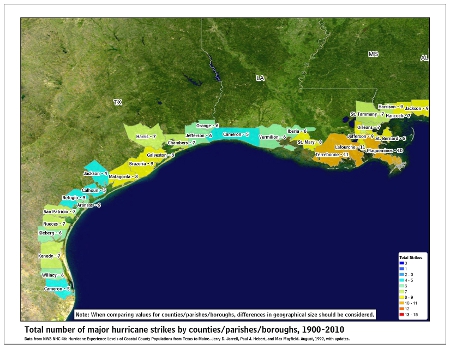Wind shear is often the most critical factor controlling hurricane formation and destruction. In general, wind shear refers to any change in wind speed or direction along a straight line. In the case of hurricanes it is important primarily in the vertical direction–from the surface to the top of the troposphere. The troposphere is the region of the atmosphere that our active weather is confined to, and extends up to about 40,000 feet altitude (a pressure of about 200 mb) in the tropics in summer. Hurricanes fill the entire vertical extent of the troposphere, and are steered by the average wind through this layer. When one hears the phrase, “wind shear is 20 knots over the hurricane”, this typically refers to the difference in wind speed between 200 mb (the top of the troposphere, 40,000 feet altitude) and a layer where a pressure of 850 mb is found–about 5,000 feet above the surface. This wind shear is computed over a large area–a circle of 700 miles in diameter centered on the hurricane is one technique used. This 200-850 mb wind shear is a crude measure of the actual wind shear a storm experiences, since only changes in wind speed–not wind direction–are considered. Furthermore, the computed shear does not consider any smaller scale changes that may occur within this large volume of the atmosphere. For example, it is common to find a strong jet of wind at about 600 mb blowing along the edge of the Saharan Air Layer (SAL)–that area of dry, dusty air that frequently lies to the north of developing tropical cyclones in the mid-Atlantic. This jet will create significant wind shear that will not show up on the standard 200-850 mb wind shear plots. Since upper-air measurements are very sparse over the open ocean, shear that is invisible on 200-850 mb wind shear analysis charts will often unexpectedly kill or weaken a developing tropical cyclone.
Tropical cyclones are heat engines powered by the release of latent heat when water vapor condenses into liquid water. Shear hurts tropical cyclones by removing the heat and moisture they need from the area near their center. Shear will also distort the shape of a hurricane by shearing it (blowing the top away from the lower portion), so that the vortex is tilted. A tilted vortex is usually a less efficient heat engine–the delicate balance of inflowing low-level winds and outflowing upper-level winds that ventilate the storm gets disrupted. Dr. Bill Gray of Colorado State University was one of the first scientists to study the effect of winds shear on hurricane formation. In his classic 1968 paper, “Global View of the Origin of Tropical Disturbances and Storms” — Source: WUG and Wiki

 DONATE
DONATE![[Map of 1950-2017 CONUS Hurricane Strikes]](http://www.nhc.noaa.gov/climo/images/conus_strikes_sm.jpg)















